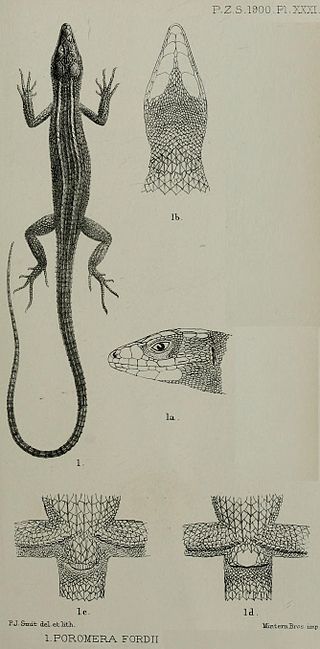
The Lacertidae are the family of the wall lizards, true lizards, or sometimes simply lacertas, which are native to Afro-Eurasia. It is a diverse family with at about 360 species in 39 genera. They represent the dominant group of reptiles found in Europe.

Adolfus is a genus of lizards of the family Lacertidae. The genus is endemic to subsaharan Africa.

Holaspis is a genus of equatorial African lizards in the family Lacertidae. These lizards are capable of gliding flight for distances of 30 meters.

Latastia is a genus of lizards of the family Lacertidae. Species of this genus are distributed in Africa but one subspecies lives in Yemen. Collectively, they are known as long-tailed lizards.

Ophisops is a genus of wall lizards of the family Lacertidae. They are small lacertids characterized by transparent lower eyelids that are completely or partially fused with the upper lids to form a cap over the eye. Species of the genus Ophisops are distributed in southeast Europe, northeast Africa, to west Asia.

Philochortus is a genus of lizards of the family Lacertidae. Species of this genus are distributed in Egypt, Algeria, Libya, Mali, Niger, Ethiopia, Djibouti, Eritrea, Somalia, Kenya, Yemen, and Saudi Arabia.

Poromera is a genus of lizard in the family Lacertidae. The genus Poromera is monotypic, containing the single species, Poromera fordii, commonly known as the West African striped lizard. The species is endemic to western Central Africa.

Pseuderemias is a genus of lizards of the family Lacertidae. Common names for the genus are false sand lizards or racerunners.

Ophisops leschenaultii, commonly called Leschenault's snake-eye, Leschenault’s lacerta, or Leschenault's cabrita, is a species of lacertid lizard endemic to India and eastern Sri Lanka. In Sri Lanka, this lizard is called Pandura katussa in Sinhala. In some parts of the country, it is also called Heeraluwa or sikanala, which is more common name for all skink-like reptiles.

The Iberian rock lizard is a species of lizard in the family Lacertidae. The species is endemic to Portugal and Spain. Its natural habitats are mountain forests, shrubland, rivers and rocky areas. It is threatened by habitat loss.
The Ukinga girdled lizard is a poorly known species of girdled lizard from central Tanzania. They are rupicolous (rock-dwelling) and feed on small arthropods.
Adolfus alleni, also known commonly as the alpine meadow lizard or the alpine-meadow lizard, is a species of lizard in the family Lacertidae. The species is endemic to Kenya.

Meroles squamulosa is a species of African lizard originally placed in the genus Ichnotropis, however phylogenetic evidence moves this species to the genus Meroles. The species is commonly called the common rough-scaled lizard or savanna lizard. It is largely found in southern Africa. These lizards are terrestrial and found in the range of mesic savannah. The common rough-scaled lizard is medium in size and well distributed in parts of Namibia, Botswana, Zimbabwe, Angola, Tanzania, and Zambia.
Ichnotropis grandiceps is a species of African lizards in the family Lacertidae. They are commonly called Caprivi rough-scaled lizards as they are largely found in southwestern Africa on the border of the Caprivi Strip. The cape rough-scaled lizards are terrestrial and found in the range of open woodland and mesic savanna. The caprivi rough-scaled lizards are medium in size and distributed in parts of Namibia and Botswana. This species is on the International Union for Conservation of Nature's Red List for endangered species as they are rare and has not been seen or collected since 1998. Data about the population or specimens collected are needed for the IUCN to obtain more information about the unknown threats that may be impacting them.
Ichnotropis microlepidota is a species of African lizard in the family Lacertidae. It is commonly called Marx's rough-scaled lizard and is largely found in Angola, Africa. I. microlepidota is a terrestrial lizard and was first discovered at the foot of Mount Moco.

Congolacerta is a genus of equatorial African lacertids of the family Lacertidae. Species of this genus are distributed in western East Africa.

Gastropholis prasina, the green keel-bellied lizard, is a species of lizard belonging to the family Lacertidae.
Adolfus masavaensis, also known as the western alpine meadow lizard, is a species of lizard. It is known from the Aberdare Mountains in Kenya and Mount Elgon on the Kenya/Uganda border. It is a moorland species found at high elevations, 2,896–3,372 m (9,501–11,063 ft) above sea level.

Congolacerta vauereselli, also known commonly as the sparse-scaled forest lizard, is a species of lizard in the family Lacertidae. The species is native to central Africa.

Holaspis guentheri, also commonly known as the neon blue-tailed tree lizard, the sawtail lizard, and the western neon blue-tailed tree lizard is a species of lizard in the family Lacertidae. The species is native to portions of West Africa and Central Africa.


















